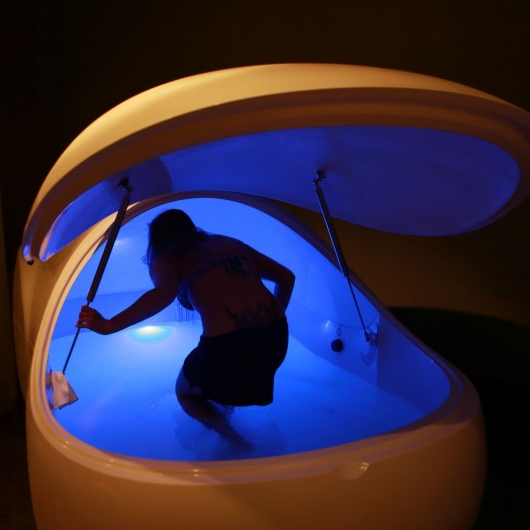Whatever floats your boat
Melburnians are letting their worries float away in new gravity-defying therapy sessions starting this month.


By SHIRIN MOTAMEDI
The city’s first combined floatation and yoga centre, Elevation Floatation & Yoga opened its doors to customers last week and it’s said to be a trip of a whole new kind.
The somewhat unconventional activity of lying inside a floatation (or sensory deprivation) pod is becoming more popular as more people learn of its apparent health benefits.
The treatment involves lying in a light- and sound-proof pod that contains a shallow bath of warm water and Epsom salts heated to skin temperature.
One of the pioneers of floatation therapy in the Asia-Pacific region, Damien Peng, said the buoyancy created by the dense salt solution created a zero-gravity sensation, providing a feeling of weightlessness.
Mr Peng said gravity occupied much of our brain’s activity.
“By eliminating our brain’s focus on constant gravity computations, floating allows the individual to deal with matters of the mind and spirit.”

Those practicing floatation lie in the pod for an average of 60 minutes, in pitch-black silence, to meditate or to help treat any number of ailments.
Advocates for the therapy said floatation had marked physical and psychological benefits that could supplement treatments for illness or injury.
“When in the floating posture, at the right temperature, the natural response of the body is to dilate the blood vessels, maximising blood flow and reducing blood pressure,” Mr Peng said.
“This deeply relaxed state fosters the release of natural endorphins which act to reduce pain and tension.”
Stress is correlated with increased levels of the hormone cortisol, which can be reduced through floatation.
Sydney businessman and floatation enthusiast Sean Jackson said he used the therapy as stress relief.
“Before I began floating, my blood tests would always indicate high levels of stress hormones,” Mr Jackson said.
“After floating one day per week for the next six months, I had another blood test and my cortisol levels were very much reduced.”
A first-time floater should not expect to be cured of anything, and may not feel completely comfortable until their third or fourth experience, Mr Jackson added.
“You may start to feel dizzy; you might feel nervous and find that your brain is racing from one thought to another.
“The first float is always very exploratory, so it’s wise to float regularly to get the hang of it,” Mr Jackson said.
Huffington Post contributor Mike Ferry trialled the therapy in the United States when it first started making tracks there.
He described his initial experience in The HuffPost’s blog as a “terrifying feeling for which I had no context to compare”. “I was wrestling a legitimate panic attack,” he wrote.
Elevation Floatation & Yoga co-founder Dinuka Bandara said uninterrupted solitude in a floatation tank could help people explore their creative intelligence.
“It is possible for a person’s creativity to thrive when they are floating, due to the deeply relaxed state and the subconscious taking over,” Mr Bandara said.
“The claims surrounding floatation sound very grandiose, but a person will be amazed how much it can change their life when they do it on a regular basis.”
Mr Bandara said no customer had had a negative experience in a floatation tank at his centre. Staff did their best to ensure people who were claustrophobic or had any mental conditions knew well in advance what they were getting themselves into, he said.
Floating through the years
Floatation is not a new phenomenon. Neuroscientist and psychoanalyst John C Lilly invented the first float tank in the 1950s to analyse how humans reacted in a sensory-deprived state.
1954: The first tank
In the early 1950s, neurologists began to question how external stimulation and human senses played into the nature of consciousness.
This led Mr Lilly to begin researching floatation therapy, developing the very first float tank.
1970s: The first boom
After nearly two decades of research, commercial tanks were produced and the floatation industry grew.
Float centres started to pop up all across the US, receiving lots of media attention.
1980s-90s: The decline
The AIDS scare of the '80s caused fear of contamination in the general public, and the float industry suffered.
Also, many users of float tanks through the '80s and '90s were hippies who took hallucinogens before floating in order to make their visions more vivid. This led the community to associate floatation with recreational drug use, having a further negative effect on the image of the industry.
2005: The rebirth
Advances in technology and further research into floatation caused interest to reignite, as people heard more about the numerous health benefits.
Many centres are now opening around the world.
Home page image from A Quiet Place Floatation Spa





